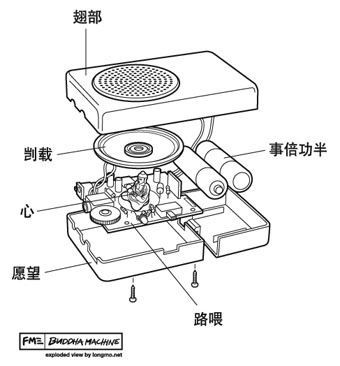Live Performance in the Age of Supercomputing
Robert Henke discusses his art.
Tag: Robert Henke
God in the machines
Fm3’s Buddha Machine.
The Electronic Qur’an.
• Compact, robust and easy to use;
• Long lasting battery life;
• Large LCD with blue backlight for night time viewing;
• Built-in audio speaker;
• Built-in DC adapter jack;
• Ability to record up to 3 hours* of voice;
• Follow and compare your own voice with the reciters;
• Excellent sound quality with AudiTrax technology;
• Inter-changeable audio plug-in system;
• Bookmark function;
• Repeat function;
• Search function;
• Full audio recitation;
• Approved/licensed Qur’an text in Arabic (Uthmanic font type);
• Approved/licensed Qur’an text in English (Mushin Khan’s translation);
• Approved Islamic contents in both Arabic and English translation.
Modern Orthodox by Elliott Malkin.
Modern Orthodox is a working demonstration of my next-generation laser eruv system. An eruv (pronounced ey-roov) is a symbolic boundary erected around religious Jewish communities throughout the world. While an eruv is typically constructed with poles and wires, Modern Orthodox employs a combination of low-power lasers, wifi surveillance cameras and graffiti, as a way of designating sacred volumes of space in urban areas.
Crucifix NG by Elliott Malkin.
Crucifix NG (Next Generation) is the principal work of the Faith-Based Electronics Group at the Interactive Televangelist Program (ITP). Crucifix NG is a printed electronic circuit board in the shape of a crucifix. This handheld, wall-mountable device houses a battery-operated transmitter that broadcasts an ASCII, non-denominational version of the Lord’s Prayer at 916 megahertz. (916 has no numerological significance – it is simply a function of the availability of low-cost transmission chips within this FCC license-free bandwidth.)
Previously on { feuilleton }
• Layering Buddha by Robert Henke
Layering Buddha by Robert Henke
Layering Buddha on CD and limited vinyl.
The Fm3 Buddha Machine is a low-fi loop playing device containing nine pre-recorded loops which cannot be changed by the user. Due to manufacturing imperfections, individual machines play the loops with a slightly different sound, pitch and duration. The built-in playback circuit, with its low sampling rate and bit resolution, produces a very rough sound, similar to ancient computer games or talking toys. Rich, spacious textures and moving echoes occur when many of these machines are played at the same time.
I recorded the sound of one single buddha machine at 96 kHz, using a state of the art A/D converter. The recording contains audio information up to 48 kHz, which makes it possible to transpose the loops down and expose otherwise inaudible hidden details. The pieces on this CD have been created by granulating, filtering, pitching and layering either the original loops, or new loops which were re-assembled out of parts of the originals. Most pieces are based on one single source loop. The pieces as they live within my computer are set up as continuously permutating structures and theoretically could go on forever, just as the loops do within the buddha machines.
I made quite long renderings of these permutations and later decided which excerpt of each structure to put on this CD. Therefore, the tracks are not closed works, but views onto a perpetual machinery.





